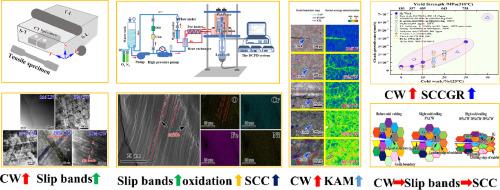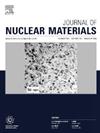Effect of cold work level on the crack propagation behaviour of 316LN stainless steel in high-temperature pressurized water
IF 2.8
2区 工程技术
Q3 MATERIALS SCIENCE, MULTIDISCIPLINARY
引用次数: 0
Abstract
We investigated the microstructure, mechanical properties, and stress corrosion cracking (SCC) propagation behaviour of 316LN austenitic stainless steel with various cold work (CW) levels. CW increased the crack growth rate of 316LN. The stress corrosion crack growth rate (SCCGR) for 316LN with 5% CW was approximately 6.52% higher than that of the solution-annealed state; 10%, 20%, and 30% CW resulted in 1.20, 3.18, and 6.10 times higher SCCGRs, respectively. A larger residual strain and proliferation of slip bands via cold deformation augmented the SCCGR. The SCC propagation mechanism of 316LN changed with increasing CW levels owing to slip bands.

冷加工水平对 316LN 不锈钢在高温加压水中裂纹扩展行为的影响
我们研究了不同冷加工(CW)水平下 316LN 奥氏体不锈钢的微观结构、机械性能和应力腐蚀开裂(SCC)扩展行为。冷加工提高了 316LN 的裂纹生长率。5% CW 的 316LN 的应力腐蚀裂纹生长率(SCCGR)比固溶退火状态高出约 6.52%;10%、20% 和 30% CW 的 SCCGR 分别高出 1.20、3.18 和 6.10 倍。通过冷变形产生的较大残余应变和滑移带的扩散提高了 SCCGR。由于滑移带的存在,316LN 的 SCC 传播机制随着 CW 水平的增加而改变。
本文章由计算机程序翻译,如有差异,请以英文原文为准。
求助全文
约1分钟内获得全文
求助全文
来源期刊

Journal of Nuclear Materials
工程技术-材料科学:综合
CiteScore
5.70
自引率
25.80%
发文量
601
审稿时长
63 days
期刊介绍:
The Journal of Nuclear Materials publishes high quality papers in materials research for nuclear applications, primarily fission reactors, fusion reactors, and similar environments including radiation areas of charged particle accelerators. Both original research and critical review papers covering experimental, theoretical, and computational aspects of either fundamental or applied nature are welcome.
The breadth of the field is such that a wide range of processes and properties in the field of materials science and engineering is of interest to the readership, spanning atom-scale processes, microstructures, thermodynamics, mechanical properties, physical properties, and corrosion, for example.
Topics covered by JNM
Fission reactor materials, including fuels, cladding, core structures, pressure vessels, coolant interactions with materials, moderator and control components, fission product behavior.
Materials aspects of the entire fuel cycle.
Materials aspects of the actinides and their compounds.
Performance of nuclear waste materials; materials aspects of the immobilization of wastes.
Fusion reactor materials, including first walls, blankets, insulators and magnets.
Neutron and charged particle radiation effects in materials, including defects, transmutations, microstructures, phase changes and macroscopic properties.
Interaction of plasmas, ion beams, electron beams and electromagnetic radiation with materials relevant to nuclear systems.
 求助内容:
求助内容: 应助结果提醒方式:
应助结果提醒方式:


